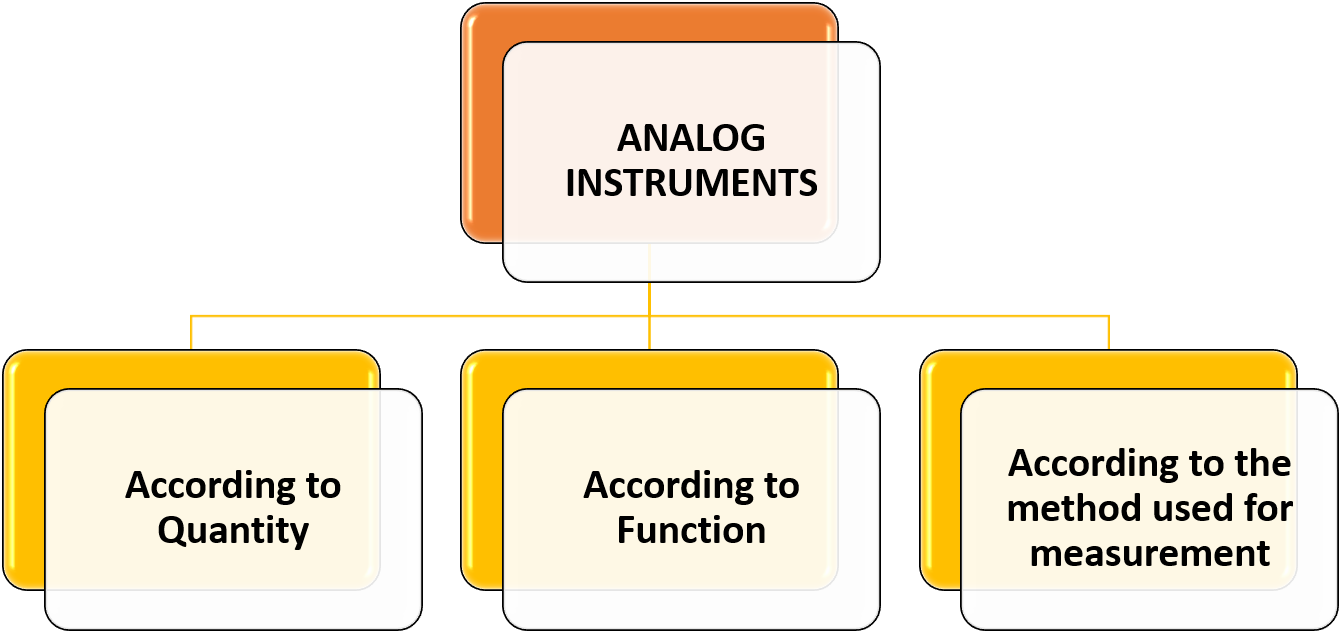In this topic, you study the definition, classification, and examples of analog instruments.
An analog instrument may be defined as the device in which the output (display) is a continuous function of the time and bears a constant relation to the input. Though analog instruments are being fast replaced by digital instruments, but today they are still in use in certain applications. Therefore, study of analog instruments is important.
CLASSIFICATION OF ANALOG INSTRUMENTS

The complete classification of analog instruments is given below.
According to Quantity
The instrument which measured current (in amperes) is called Ammeter and which measures voltage (in volts) is called Voltmeter and so on. See Table. 1.
Table 1. Analog Instruments
| Quantity | Name of the Instrument |
| Current (Amp)
Voltage (Volts) Power (Watts) Energy (W.h.) Frequency Power factor |
Ammeter Voltmeter Wattmeter Kilowatt-hours meter or energy meter Frequency meter P.F. meter |
(a) According to the kind of voltage or current that can be measured, the instruments are classified as.
- AC Instrument
- DC Instrument
- AC/DC Instrument
(b) According to the “effect of current” utilized by the instrument, they are classified as Magnetic Instrument, Heating Instrument and so on.
According to Function
Indicating Instruments: Which indicate the instantaneous value of the quantity with the help of a pointer, which moves on the scale. Ordinary voltmeter and ammeters are the examples.
Recording Instruments: Which maintain record of a fluctuating quantity by drawing a graph with the help of a pen (in place of pointer), which moves on a paper (in place of scale) e.g. E.C.G.
Integrating Instruments: Which integrates the quantity under measurement, for a specified time. e.g., Energy meter, speedometer.
According to the method used for measurement
Direct Measuring Instruments: They measure the quantity directly by using energy of the quantity itself for moving their deflection system e.g. ammeters, voltmeters etc.
Comparison Instruments: They measure the quantity by comparing it with a standard e.g., dc. and ac. bridges, which are used for measuring inductance and capacitance.
EFFECTS OF CURRENT UTILIZED BY ANALOG INSTRUMENTS
The instruments utilize one of the effects of current for their operation. The important effects are under:
- Magnetic effect
- Thermal effect
- induction effect
- Hall effect
- Electrodynamic effect
- Electrostatic effect
- Chemical effect
The table 2. shows the effects and the instruments utilizing these effects-
Table 2. Various Effects
| Effects | Instruments |
| Magnetic effect
Electrodynamic effect Thermal (heating) effect Electrostatic effect Chemical effect Hall effect Induction effect
|
Ammeters, voltmeters. wattmeters.
Voltmeters. ammeters. wattmeters. Ammeters & voltmeters Voltmeters Amp. Hr. meters Flux meters, transducers. A.C. ammeters, voltmeters, wattmeters. energymeters |